Protecting the Planet from Nuclear Terrorism
Air Date: Week of July 10, 2009
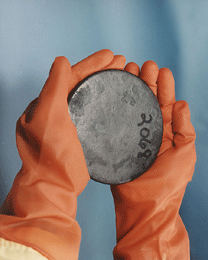
Highly-enriched uranium. A football-sized amount it is sufficient to make a nuclear bomb. (Courtesy of the Department of Energy)
President Barack Obama wants to host a global summit on nuclear security next year. He's called nuclear terrorism the gravest threat the world faces, and political scientist Graham Allison agrees. Graham Allison, author of the book "Nuclear Terrorism" tells host Steve Curwood that we're more likely than not to experience a nuclear or biological weapons attack in the next five years-- a preventable tragedy that would change the world forever
Transcript
CURWOOD: It’s Living on Earth, I’m Steve Curwood.
YOUNG: And I’m Jeff Young.
President Obama returned from his trip to Moscow with an agreement in principle for the US and Russia to reduce nuclear arsenals by up to a third. It’s one of many steps experts say must be taken to deter proliferation and keep nuclear weapons out of the hands of terrorists.
The Mid East and Asia are rife with nuclear tension. Israel is presumed to have the Bomb, and just last month a senior al Qaeda leader said his group aims to seize Pakistan's nuclear arsenal and use it against Americans. The threat was underscored by the recent suicide bombing of a bus carrying workers from a Pakistani nuclear lab.
CURWOOD: Defense expert Graham Allison says the threat of nuclear terrorism and the resulting human and ecological devastation is greater now than ever. Graham Allison was assistant secretary of defense during the Clinton administration, and is now a professor at Harvard University's John F. Kennedy School of Government.
Professor Allison, welcome to Living on Earth.
ALLISON: Thank you very much for having me.
CURWOOD: And you recently have been serving the federal government with the Weapons of Mass Destruction Commission. Tell me about that work.
ALLISON: Well Congress established a year ago a Commission on Preventing Weapons of Mass Destruction Proliferation and Terrorism - so it’s a mouthful – as a successor to the 9/11 Commission. And we issued our report in December and carefully after a lot of debate and deliberation entitled it “World at Risk.” And the conclusion was that on the current trajectory, terrorists will successfully conduct a nuclear or biological terrorist attack somewhere in the world in the next five years. That’s more likely that not. We’re losing ground. We’re less safe today than we were five years ago. And we’ll be less safe five years from now. So it’s a call for bending the trend lines that are otherwise leading us to a pretty catastrophic consequence.
CURWOOD: Let’s talk about the fundamentals of the threat here. What are the scenarios that you look at in terms of a nuclear terrorist attack?
ALLISON: In the book that I published in 2004 called Nuclear Terrorism: the Ultimate Preventable Catastrophe, in the introduction, I tell the story of Dragonfire.
CURWOOD: Dragonfire?
ALLISON: Dragonfire. Dragonfire is the name of a source, and intelligence source, who reported just one month to the day after 9/11 that al Qaeda had got a small nuclear bomb out of the former Soviet arsenal and brought that bomb to New York City and might be about to explode it.
CURWOOD: Sounds like a movie.
ALLISON: It does sound like a movie. When George Tenet who was then the director of CIA went to give the President’s daily intelligence briefing he explained this to President Bush, and there was a moment to catch breath and then a interrogatory that went something like the following: Did the former Soviet arsenal include weapons of the description of the bomb that Dragonfire had provided? Answer: yes. Were all those weapons adequately accounted for? Answer: No. Could al Qaeda have gotten one of those weapons and brought it to New York City and be about to explode it and we not otherwise know anything about it? Answer: Yes.
So the conclusion from this was there was no basis for dismissing Dragonfire’s report. And on this basis the President ordered nuclear experts to go to New York to look for signs of radiation. And for months after this event, Cheney was missing from Washington because the thought was maybe there would be a bomb in Washington and if it exploded in Washington would destroy the government we have. We would still like to have political authority, so there’s an alternative site that was created during the Cold War where Cheney and actually a couple of thousand people from the agencies of the U.S. government went and stay for some months. Now it turned out to be a false alarm. But the important take away from this is that there was no basis in science, no basis in technology, no basis in logic for dismissing an account that al Qaeda, the guys that just 3,000 people, now had a weapon that would kill 300,000 people.
CURWOOD: So how easy is it, if someone wanted to, to get a hold of nuclear weapons?
ALLISON: Well fortunately you can’t just order up a nuclear weapon from the Internet. Thank goodness. There’s not any for sale on eBay. The happy good news is that is that it’s much more complicated than first blush. Without fissile material, you can’t make a mushroom cloud. Fissile material comes in only two brands: highly enriched uranium and plutonium.
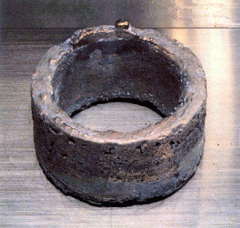
Weapons-grade plutonium. (Courtesy of Department of Energy)
CURWOOD: Or accounted for?
ALLISON: Or even accounted for, because in the former Soviet Union, you had this vast undertaking during the Cold War in which it’s not even clear they knew how much material or how many weapons they ultimately created.
CURWOOD: And as I understand when the Soviet Union collapsed the Stans had a lot of these weapons, Uzbekistan, Turkmenistan…
ALLISON: Ukraine, Kazakhstan. Absolutely. Now I was Assistant Secretary of Defense in 1993, so the beginning of the Clinton administration. And one of the first things I did was with a person from the State Department, we traveled around the places where these nuclear weapons were or had been. Now at the time that the Soviet Union disappeared, so that’s December 1991, there were about 14,000 nuclear weapons, best estimate, left outside of Russia. There were 2620 weapons in Ukraine, about 1000 weapons in Belarus, and we believe all those nuclear weapons were taken out of those fourteen states and back to Russia.
That’s what we believe, in the sense that we haven’t found one anywhere else. But if you said is it possible that some went missing? The answer is: it certainly is. And is it possible that some material from which terrorists could make a bomb went missing? Certainly is. There was a very good report that George Tenet says something about in his memoir of people negotiating to buy four bombs. These were al Qaeda folks in Saudi Arabia. Again, people tried to trace down this story and never got to the bottom of it. There have been rumors that Iran may have bought one or two or several such weapons. So, we haven’t found one of these weapons so far. And I give thanks for that every day. But we don’t know what we don’t know.
CURWOOD: So if someone got ahold of these materials, how easy, how difficult would it be to say bring them into the United States?
ALLISON: That’s a unfortunately an easy question to answer, because one needs to ask how many illegal things of approximately that size come into the U.S. every day? Now, every city knows that drugs come to the U.S. How do they get here? They come in cargo containers, they come in ships, they come across the Mexican border, they come across the Canadian border, they may come in a cell boat. We’re here in Boston, how hard is it to get into a cell boat and sail to Canada? And to sail back? And if you put your cell boat in Marblehead, do you cross some line in the ocean that says you’re entering American water? No, of course you don’t. And when you arrive at the dock in Marblehead, does somebody inspect your boat? No, of course they don’t. So I would say unfortunately the ability of terrorists to bring a weapon to target, we just say follow the drugs.
CURWOOD: And one needs about what – ten pounds of plutonium?
ALLISON: Well ten pounds of plutonium would be sufficient for making a bomb. The easier form of a bomb would be highly enriched uranium. And there ideally you would have about 100 pounds of highly enriched uranium. But its very dense stuff, so this would be smaller than a football.

A billet of highly enriched uranium. (Courtesy of the Department of Energy)
ALLISON: It is. It is. But unfortunately the 9/11 looked like for many people an unbelievable movie that they simply couldn’t imagine. We have to remember that the U.S. who’s the only country to ever use nuclear weapons against another state dropped first a bomb on Hiroshima.
CURWOOD: A small city.
ALLISON: A small city and secondly, a few days later, on Nagasaki.
CURWOOD: Another small city.
ALLISON: Another small city. And at that point, the Emperor of Japan said “uncle, I give up.” So, if one bomb exploded just in one city, a small city, and if there were threats that there were weapons in other cities, well, of course, the question now the president would be wrestling with and his advisors is how likely is it that these guys have another bomb. And since a president couldn’t be seen to be yielding to such blackmail, I suspect you would play it out for the second round. But now, if you’re playing your movie, now two bombs in a second city’s gone off and the threat of a third city. So this is a nightmare.
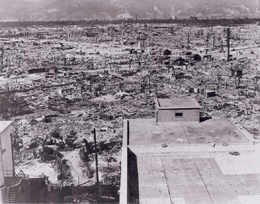
Hiroshima after the United States nuclear attack, which immediately killed about 70,000 people. Tens of thousands more died in the months and years to follow. (Courtesy of the Department of Defense)
ALLISON: Yeah, and I would think you could easily imagine people in cities self-evacuating. Go back to the Dragonfire story that I mentioned to begin with. President Bush decided not to inform the City of New York, including Mayor Giuliani. Remember, this is the month after 9/11. Giuliani’s been the man on the scene, the mayor. So they didn’t inform him about the Dragonfire report that there was a nuclear bomb in the city. And why didn’t they inform him? Because if you inform the mayor, he’s gonna inform the police commissioner. And the police commissioner is going to inform the assistant police commissioner. And pretty soon there’s gonna be a story out that President Bush believes there might be nuclear bomb in New York City, a month after 9/11. You would have had people fleeing the city massively. That thought this would be a panic.
CURWOOD: Now, one thing we haven’t talked about here is a state using a nuclear bomb. Now some folks say that well actually nuclear bombs are pretty useless for states. Why do they say that?
ALLISON: In general, if a state were to use a nuclear weapon, particularly to deliver a weapon via missile against another state – let’s take North Korea – the attack would leave an unambiguous return address. And North Korea would know that the U.S. would know that this missile came from this particular place in North Korea, and the U.S. would respond to this with an overwhelming retaliatory response.
So, the reason why a state would not rationally attack a state that has nuclear weapons like the U.S. with a nuclear weapon is that it would be suicidal. Terrorists who deliver a bomb are not gonna deliver it by a missile. They’re gonna have delivered it by bringing it in the hull of a ship that comes into a harbor, so when the bomb explodes, we’re not gonna be able to identify this unambiguous return address. It’s a huge advantage for a terrorist relative to a state.
Secondly, some terrorists appear to want to be suicidal. So, when you’ve got somebody who is prepared to die in the course of conducting their attack, the threat to kill ‘em doesn’t have quite the same deterrent effect.
CURWOOD: So, if it’s difficult, if almost impossible for a state to use a nuclear weapon, why all the brouhaha about Iran getting nuclear weapons?
ALLISON: Well, that’s a very good question. If Iran succeeds with its current project which will give it a nuclear bomb sometime in the 2012, 13 period perhaps, is that likely to be the end of the story in the region? Or will not Saudi Arabia, which thinks of itself as the leader of the Sunni Muslim community, demand to be equivalent? Will not Egypt which thinks of itself as the political leader of the area?
So most people including myself believe that if Iran becomes a nuclear weapon states, we’ll see a knock-on effect, in effect a cascade of proliferation in the region. The region is already extremely volatile. And in a situation in which other states are pursuing or about to get nuclear weapons, in which Israel probably would attack somebody along the way, one would expect that this would be a very destabilizing scenario. In the same way that if North Korea becomes a recognized nuclear weapon state, most people, including myself, believe that this will end up having a corrosive effect on Japan and maybe South Korea. And as a consequence, if we look at these two virgin cases today, both of them of which are losing hands, I mean, to tell the truth. And the North Korean hand – North Korea has ten bombs worth of plutonium and has conducted a second test. And we can say “you simply can’t do that” but they did it.
So when both of these cases, if they should become nuclear weapon states, I think the whole non-proliferation regime is likely to unravel. And then we would be in a world of multiple nuclear weapon states in which they’re leap-frogging each other – in which I would think it’s likely that nuclear weapons would be used in one or more cases, and that some weapons will become loose and so there’ll be even more opportunities for people like terrorists to destroy our cities.
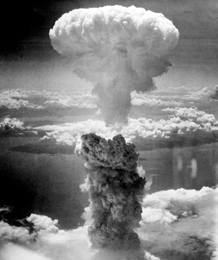
The mushroom cloud from the “Fat Man” bomb rose 18 kilometers into the air over the small city of Nagasaki, Japan. (Courtesy of the Department of Defense)
ALLISON: Well… nuclear or biological.
CURWOOD: Nuclear or biological.
ALLISON: We worked our way through this and we certainly took testimony from all the experts across the U.S. government, from experts in other governments including the British government, the Pakistani government. Unfortunately, the physical facts are such as they are, that there’s people with motive, there’s potential means, and there are huge opportunities. And you put all that together and it seems more remarkable that something terrible hasn’t happened than that something terrible would happen.
CURWOOD: So, as a former assistant secretary of defense, as a person with all the security clearances in this area, you’re sitting here telling me really, it would have been more likely that this would have already happened than not.
ALLISON: In my view. Just because we can now vividly imagine al Qaeda getting a nuclear bomb, bringing it to an American city, destroying the heart of that city, and changing our world. You look at the means available, you look at the opportunity, and I give thanks that it hasn’t happened. But this is a preventable catastrophe.
CURWOOD: How?
ALLISON: There’s a feasible, affordable agenda of actions that if we took, we’d reduce the likelihood of this to nearly zero. And they’re a long complex list, but the core of it is that on the supply side there’s this happy syllogism from physics: no fissile material, no mushroom cloud, no nuclear terrorism. So fortunately they can’t make the fissile material.
What we have to do is make sure that all nuclear weapons everywhere and all nuclear material is locked up as good as gold. How much gold has the U.S. lost from Fort Knox? Zero. So do human beings know how to lock up things that we really care about? Yes, of course we do. Well is there some reason why nuclear weapons and materials should be less secure than gold? I mean, what is gold?
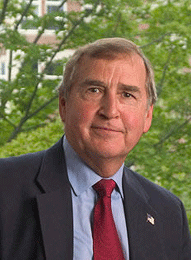
Graham Allison. (Courtesy of Harvard University)
If there are things we can do that reduce the likelihood of that to nearly zero, what in the world are we doing?”
CURWOOD: What are we waiting for?
ALLISON: What are we waiting for? Exactly.
CURWOOD: Graham Allison is author of Nuclear Terrorism: The Ultimate Preventable Catastrophe. He’s a political scientist at Harvard University’s John F. Kennedy School of Government. Professor Allison, thanks so much for your time.
ALLISON: Thank you very much for having me.
Links
For more on Graham Allison, click here.
Click here for more on nuclear terrorism and Graham Allison’s book.
Living on Earth wants to hear from you!
Living on Earth
62 Calef Highway, Suite 212
Lee, NH 03861
Telephone: 617-287-4121
E-mail: comments@loe.org
Newsletter [Click here]
Donate to Living on Earth!
Living on Earth is an independent media program and relies entirely on contributions from listeners and institutions supporting public service. Please donate now to preserve an independent environmental voice.
NewsletterLiving on Earth offers a weekly delivery of the show's rundown to your mailbox. Sign up for our newsletter today!
 Sailors For The Sea: Be the change you want to sea.
Sailors For The Sea: Be the change you want to sea.
 The Grantham Foundation for the Protection of the Environment: Committed to protecting and improving the health of the global environment.
The Grantham Foundation for the Protection of the Environment: Committed to protecting and improving the health of the global environment.
 Contribute to Living on Earth and receive, as our gift to you, an archival print of one of Mark Seth Lender's extraordinary wildlife photographs. Follow the link to see Mark's current collection of photographs.
Contribute to Living on Earth and receive, as our gift to you, an archival print of one of Mark Seth Lender's extraordinary wildlife photographs. Follow the link to see Mark's current collection of photographs.
 Buy a signed copy of Mark Seth Lender's book Smeagull the Seagull & support Living on Earth
Buy a signed copy of Mark Seth Lender's book Smeagull the Seagull & support Living on Earth

